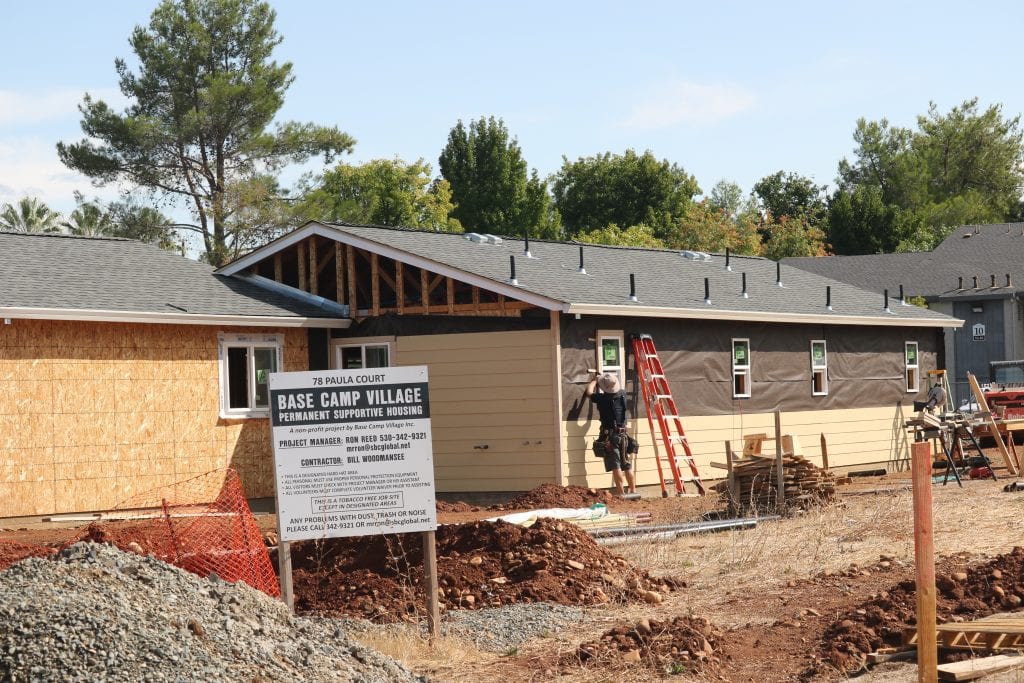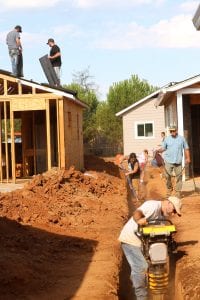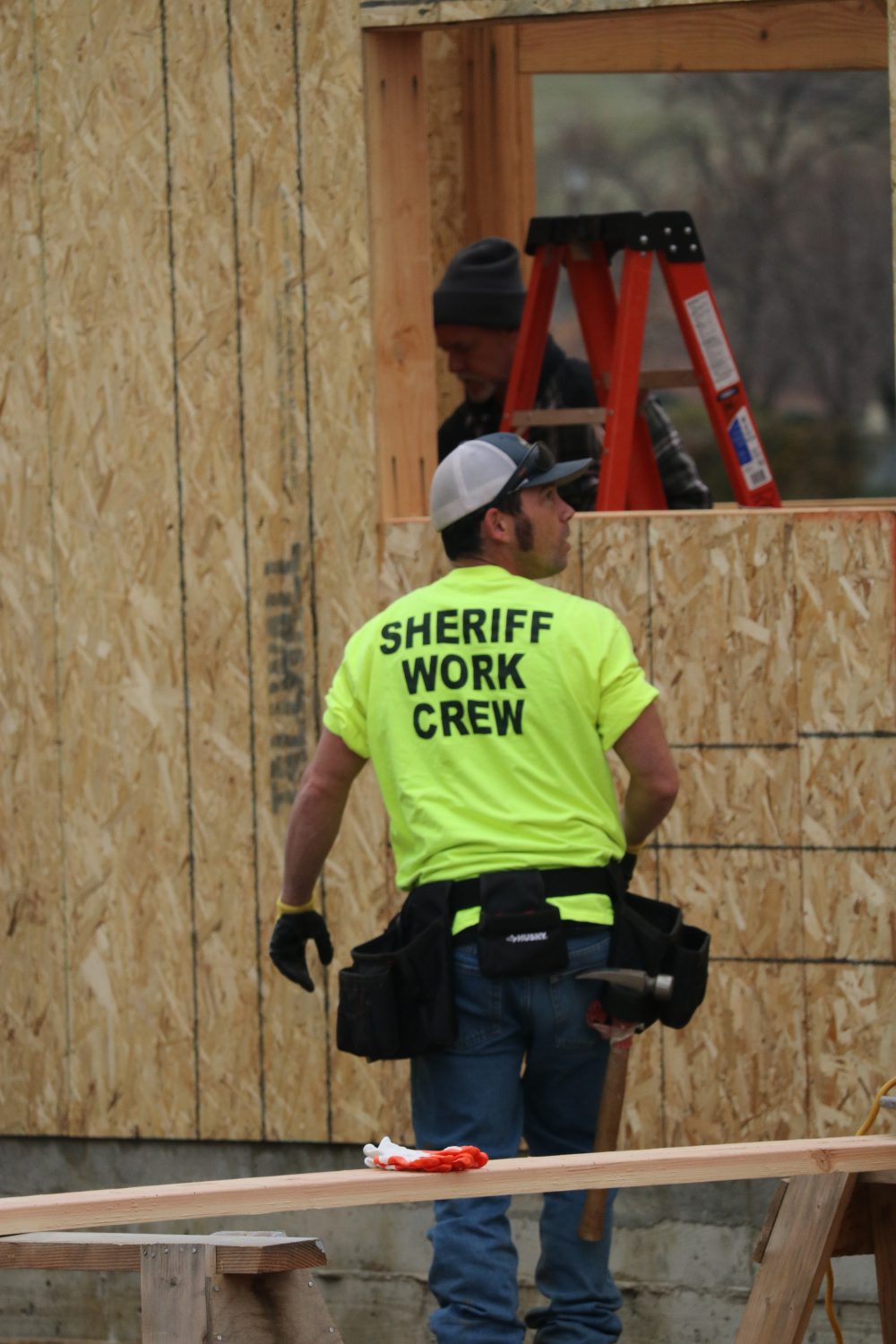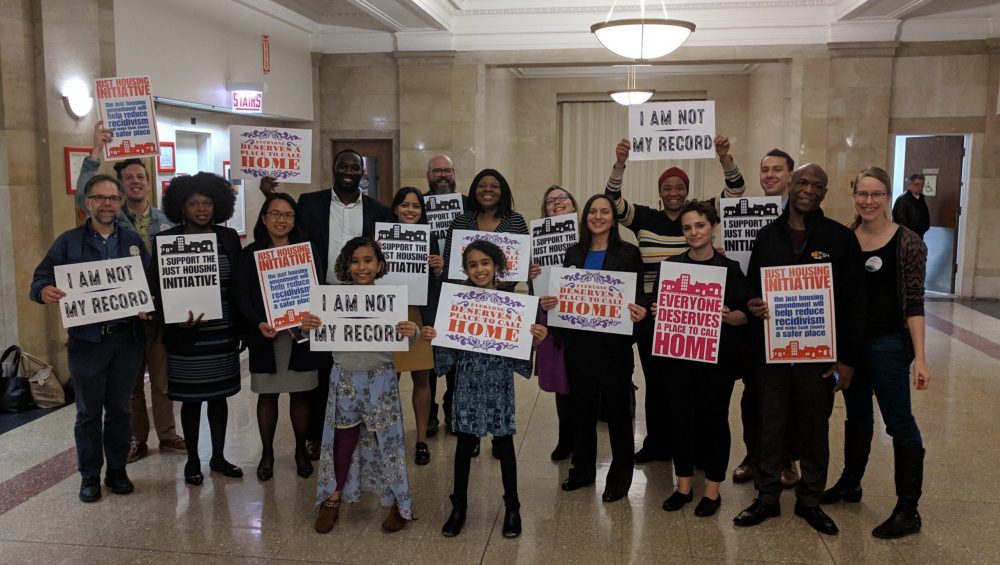
Base Camp Village, a nonprofit in California, uses inmate labor from Butte County to build an affordable housing apartment complex for the homeless. Photo courtesy of Base Camp Village
Programs aimed at creating affordable housing and providing crucial job training for inmates can trace their roots to an innovative program created in South Dakota in the late 1990s.
Bill Janklow, a conservative Republican nicknamed “Wild Bill,” pledged to make affordable housing a priority when he was elected to a third term as South Dakota’s governor in 1994. Janklow, who died in 2012, spearheaded what’s now known as the Governor’s House Project: small homes built at a lesser cost because they are constructed by inmates who work for free.
The program faced some initial resistance from for-profit builders, but Janklow told the New York Times in 1998 that he wanted to protect the vitality of South Dakota’s small towns while providing inmates with “dignity and self-respect” in the form of job training.
Twenty-three years after the program launched, more than 2,000 homes have been sold—two-bedroom houses today can cost $49,700. And in 2019, inmates worked a total of 142,060 hours building the homes, according to the South Dakota Housing Development Authority.
The program has also inspired a similar one that’s set to launch in Missouri this year, while another project in northern California is using inmates to build a 12-unit apartment complex intended for the chronically homeless.
This all comes as the national conversation on inmates and ex-offenders is turning sharply toward reform. One of the few major bipartisan measures that has received Congressional approval and the signature of President Donald Trump was the First Step Act, a law that shortens sentences for some offenders and expands job training for those who are incarcerated.
Rupert Catizon, who works for the St. Louis-Kansas City Carpenters Regional Council and is involved in the Missouri project, says people across the political spectrum are realizing that a focus on imprisonment and harsh sentences has led to more problems with recidivism, and has placed roadblocks in front of people who are trying to find a new path.
“We’ve done an injustice to people who are trying to come out and get their lives back on track and find a career path,” he says.
But with the rising focus on rehabilitating inmates comes increased awareness of prisoner exploitation. The Prison Policy Initiative says that when inmates are paid for labor, they can receive as little as nine cents an hour. Inmate advocates are pushing for better standards for workers behind bars.
“They’re providing a service that has value and they should be compensated for it just like everybody else,” says Alex Friedmann, managing editor of Prison Legal News and an advocate for the rights of incarcerated people.
Affordable Housing Crunch
It’s not news that home sale prices are soaring nationwide. Zillow put the median sale price in the United States at $237,000 in August 2019, up from $149,000 in 2012.
This has led public officials from coast to coast to renew their focus on housing affordability. While eye-popping housing costs in places like New York City and San Francisco make headlines, rural America faces the crunch too. And statistics show it may be getting worse there than in more expensive destinations.
The Pew Stateline news service looked at census data from the early years of the Great Recession (2006-2010) to data from the economic recovery (2013-2017) and found that almost one-fourth of the nation’s most rural counties saw the number of their severely cost-burdened households increase. That means those families are spending at least half their income on housing. Meanwhile, the share of severely cost-burdened households dipped in places like Cape Cod, Seattle, and Manhattan, according to Pew Stateline.
Affordable housing advocates warn that small communities will hemorrhage residents if costs don’t come down.
“If you don’t have quality, affordable housing, people are going to keep driving down the road until they find a community that provides it,” says Brent Engel, spokesman for Missouri-based nonprofit North East Community Action Corporation (NECAC).
NECAC hopes to help alleviate the affordable housing problem and help inmates prepare for life outside of prison with the Aspire Partnership Prison Homes Program, which is set to launch this year. Working with the St. Louis-Kansas City Carpenters Regional Council, NECAC will use inmates in Missouri’s Bowling Green correctional facility to build small, 600-square-foot homes. As with the South Dakota program, NECAC plans to build the homes on jail property and later have them moved to their destinations. The inmates will not be paid.
The single-family homes are small to keep them affordable and for logistical reasons: larger ones won’t fit through the secure exits from participating prisons.
NECAC will then work with potential buyers in rural communities to get them loans through private lenders or federal mortgage programs. Anyone who wants to buy a home would be eligible, according to Carla Potts, the group’s deputy director. NECAC hopes to “start small” with about 10 homes in the first year of the program. The homes are intended for rural communities because they don’t meet size requirements for more urban communities, Potts says. When NECAC starts building larger homes down the road, it will reach out to homebuyers in more urban areas.
Engel says the homes will cost lower than $50,000, much lower than the median list price for a home in Missouri, which according to Zillow is $167,100.
Potts says the program was inspired by the Governor’s House Project. During a visit to South Dakota for work, she heard about the governor’s houses and decided to “add a little twist” by getting the carpenters union involved. NECAC and the union had a prior working relationship.
“The important thing for the inmates who go through this program is that at the end there’s a job,” says Potts, who added that the union will train the inmates. Once they are released, the union will enter them into an apprenticeship program to become journeyman carpenters. “If you come out and you don’t have a job you tend to go back to what you know, and what you know is what got you into prison.”
NECAC and jail officials are still working out program details, including determining which inmates will be eligible to participate, says Potts.
Ex-offenders have historically faced hostility from private companies when entering the work force post-release, which governments nationwide have tried to discourage in recent years. According to the National Employment Law Project, 35 states and over 150 cities and counties have adopted “ban the box” legislation, which aims to stop employers from immediately discarding an ex-offender’s job application.
Labor unions have been friendlier to former inmates. For instance, the Oregon AFL-CIO joined with civil rights groups in 2014 in support of a “ban the box” law. Unions in Virginia helped register ex-offenders to register to vote in advance of the 2016 presidential race. And in New Jersey, unions work directly with a prisoner re-entry group to help ready former inmates for the job market.
Unions no doubt have a financial interest here too. The United States has seen a marked decline in union membership in the last four decades, according to the U.S. Bureau of Labor Statistics. In 1983, 20.1 percent of all workers were union members. In 2018, the figure was 10.5 percent. And much of the decrease stems from the loss of private-sector union jobs, which are one-third of what they were in 1983. Training inmates and ex-offenders to become tradespeople helps add to the ranks of card-carrying, dues-paying unions.
But Catizon of the St. Louis-Kansas City Carpenters Regional Council attributed their willingness to work with those who have been formerly incarcerated to unions’ “focus on the people, the members, and the community.”
“If we can build people’s lives and help their lives become better by having a career that gives them an affordable way to live and support their family while also helping the community grow through creating businesses, creating homes, creating retail stores, creating employment for the community, then it’s a win-win,” he says.
Homes for Homeless
An inmate labor project in Oroville, California, aims to connect affordable housing with a very specific population: the chronically homeless.
California has the largest homeless population of any state, at 129,972, according to the National Alliance to End Homelessness. Per capita, 33 in 10,000 Californians have no homes, putting the state behind only Hawaii and New York (both with 46 per 10,000) and Oregon (35 per 10,000).

Base Camp Village, a nonprofit in California, uses inmate labor from Butte County to build an affordable housing apartment complex for the homeless. Photo courtesy of Base Camp Village
A 2017 report from the Butte Countywide Homeless Continuum of Care found Oroville had the second highest count of homeless people in Butte County that year, at 713. That represents an 83 percent spike from 2015.
Construction on a 12-unit apartment building for the formerly homeless, financed and overseen by the nonprofit Base Camp Village, started in January 2019 in the 15,000-population city one hour north of Sacramento.
The project is located at 78 Paula Court, about one mile south of the county jail. Mia Rae Kirk, executive director of Base Camp Village, said about 30 Butte County inmates have worked on the apartment building in the last year. She says the workers, who are unpaid, cannot be in prison for violent or sexual crimes, must get approval from jail officials to participate in the program, and wear ankle monitors while working. Most participants are drug offenders.
The mission here is the same as in South Dakota and Missouri: to provide inmates a pathway to employment after release.
Butte County was home to the deadly Camp Fire wildfire in November 2018, which claimed 85 lives and destroyed over 18,000 buildings. The town of Paradise, about 20 miles south of the Base Camp Village site, was nearly leveled. Rebuilding permits began to be issued in March 2019.
“There’s a lot of construction about to happen here,” Kirk says. “We hope that they can get a job in the construction field when their time is served.”
There’s also a financial incentive for the nonprofit. Using unpaid inmates as workers will save Base Camp Village about $300,000 in labor costs, according to Kirk, who noted that because the workers are initially unskilled, construction takes longer than a project built traditionally. The cost savings will help make the rent affordable for residents, who will pay 30 percent of their income to live there.
The Dangers of Exploitation
Inmate advocates warn that the use of unpaid labor behind bars exploits prisoners for cheap labor.
The Bureau of Justice Statistics reports that the number of incarcerated individuals under state or federal jurisdiction was 1.49 million in 2017, down 1.2 percent from the previous year. About half of Americans living behind bars have full-time jobs, according to the American Prospect.
The nonprofit Prison Policy Initiative lays out the numerous ways an inmate can work while incarcerated. There are jobs that support the functioning of the prisons—such as custodian or cafeteria worker. There are jobs for state-owned industries, known as correctional industries, making products sold to public entities, such as license plates. Some inmates work outside of jail in work-release programs, and others work for private industries that work inside prisons.
The average maximum wage for prison jobs has declined from $4.73 a day in 2011 to $3.45 a day in 2017, according to Prison Policy Initiative. Inmates in Alabama, Arkansas, Georgia, and Texas earn zero dollars for these jobs. Private industries that work inside prisons are required to pay the standard minimum wage, but inmates’ earnings from those jobs may be garnished to recoup some of the cost of their incarceration.
On Sept. 9, 2016, to mark the 45th anniversary of the Attica uprising—when inmates in the western New York prison began rioting over horrible living conditions—prisoners around the nation staged a coordinated strike by not showing up to their jobs. Strike organizers did not issue a single list of demands, but nationwide, inmates sought better pay, better living conditions, and access to education.
In California, more than 2,000 prisoners were on the front lines battling deadly wildfires this year, earning no more than $27 a day, according to Fortune. In Pennsylvania, attorneys for three ex-prisoners have sued Lackawanna County, alleging it is coercing inmates to work in dangerous conditions at a private recycling plant for just $5 a day. And Mike Bloomberg recently came under fire because his presidential campaign used prison labor to make campaign calls.
Even when nonprofit programs aim to help inmates in their post-release lives, the inmates should be paid, says Friedmann, the managing editor of Prison Legal News.
“Let the members of the nonprofit work for the same wages and see if they like it. See if they think they’re being exploited at 50 cents an hour,” he says.
The people behind Missouri’s plan to construct homes in prisons and Base Camp Village say they are aware of concerns about inmate exploitation. They both noted that the inmates who work on their projects would be working otherwise, by trimming trees along county highways or picking up trash.
“They’re getting mentorship and soft skills by going out and working on (our) crew,” says Kirk of Base Camp Village. “Not to say that they aren’t getting something from that other crew, because it’s better than sitting in jail. The alternative is our project, which we think offers them some benefits.”
Potts of the North East Community Action Corporation made a similar argument, likening most inmate labor in Missouri to busy work. The work they do for Potts’ group is more valuable, she says.
“Now they’re building little sheds, but tearing them down once they build them,” she says. “What we’re doing is taking some of those skills and enhancing those skills and linking them to a job upon their release.”
Friedmann acknowledges that the nationwide conversation around the treatment of inmates and ex-offenders has changed, but he notes that the number of incarcerated people in the United States has barely budged in the last decade, leading him to think that while people are discussing ways to treat inmates better, the words have not yet been translated into action. He says his group is in favor of inmate labor, but wants standards like minimum wages and the right to organize.
“If they’re good enough to fight wildfires and build houses, then they should have the same protections and benefits as any worker,” he says.






A similar program was recently launched in Iowa: https://www.homesforia.com/. I don’t know the exact requirements for the offenders who participate in Iowa’s program, but it’s interesting that the inmates working in the Oroville are incarcerated for drug offenses. My first thought was, “why are they still there to begin with?” Between the pandemic and re-energized discussions about criminal justice reform, hopefully more states are questioning the length of sentences for drug offenses. If these inmate-labor affordable housing programs are going to be around for awhile, hopefully they’ll take some risks and provide opportunities to violent offenders who are within two or three years of release.